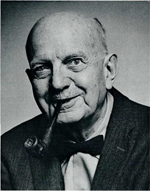In Memory of Henry Van Wagenen Howe
1896-1973
 When Henry Van Wagenen Howe died in his home in Baton Rouge, Louisiana on September 27, 1973, a brilliant career as geologist, paleontologist, teacher, and administrator ended. He is survived by his wife Evelyn; two daughters, Eleanor, a chemistry teacher at Del Mar College, and Patricia, a housewife; two sons both with doctorate degrees in geology, Herbert teaching at Purdue University, and Robert teaching at Indiana State; and six grandchildren. He was 77 years old.
When Henry Van Wagenen Howe died in his home in Baton Rouge, Louisiana on September 27, 1973, a brilliant career as geologist, paleontologist, teacher, and administrator ended. He is survived by his wife Evelyn; two daughters, Eleanor, a chemistry teacher at Del Mar College, and Patricia, a housewife; two sons both with doctorate degrees in geology, Herbert teaching at Purdue University, and Robert teaching at Indiana State; and six grandchildren. He was 77 years old.
"Heinie" or "Doc," as he was known by his colleagues and students respectively, warranted and received many honors in the latter years of his life. One very meaningful honor was the dedication of the 1957 convention of the Gulf Coast Association of Geological Societies to Dr. Henry V. Howe. Upon his return from the convention held in New Orleans, Doc told me that the Transactions of that meeting contained the finest obituary any man could possibly read while still alive. I feel, therefore, that the statements relative to his life up to 1957 would please Doc in being the excluded initial portion of this obituary, having been published previously on pages 337 and 338 of the Transactions in Volume VII.
Not recorded in the 1957 commemorative are his efforts in helping to save the Society of Economic Paleontologists and Mineralogists. Doc was one of the charter members of the organization, and served as president pro tempore at the first meeting of the Society held in Dallas, Texas, in March of 1926. He was elected, subsequently, secretary-treasurer in 1937 and 1938, and was again elected president in 1941. According to Doc's contemporaries, changes in the constitution and by laws of the constitution and in the publishing of the Journal of Paleontology, insisted upon by Doc Howe while he served as secretary-treasurer, put the Society in the black.
Keeping people and organizations in the black appears to have been one of Doc's attributes. In 1938 he established a graduate student loan fund with the University, and 1964 he was asked by the Commissioner of the Louisiana Department of Conservation to assist in keeping the State of Louisiana in the black. Doc's leadership as chairman of the Louisiana Mineral Board during its inception in 1937 apparently induced the Commissioner to request that he again assume Chairmanship of the Board in 1964. The added responsibilities as Chairman in 1964 can be attributed to the fact that among potential oil and gas producing properties owned by the state, many now lay off its shores in the Gulf of Mexico, a realm of uncertainty to all involved. According to C. J. Bonnecarre, Secretary to the State Mineral Board, "his (Doc Howe's) name and his deeds are indelibly inscribed in the Board's history."
Not chronologically presented in this obituary is, in my estimation, the greatest honor bestowed upon Doc—the receipt of the Sidney Powers Medal. This award was presented at the April 26, 1960 meeting of the American Association of Petroleum Geologists in Atlantic City. It was assurance to Doc that he warranted national recognition for what he had contributed to the fields of geology and paleontology. Later he used the wording in the citation to assure any undergraduate, who accused Doc of not clearly presenting material in his Physical Geology lectures, that there was reason to doubt the accusation. The wording of the Sidney Powers Medal award follows:
"For outstanding contributions to petroleum geology through research in stratigraphy and micropaleontology; for distinguished service to the profession by organizing and guiding the development of a leading school of geology at Louisiana State University, and by inspirational teaching of many of industry's geologists and micropaleontologists."
In the field of paleontology, Doc's initial interest, locally, was in the Foraminifera of the Gulf Coast Tertiary. Congestion of workers therein induced him to abandon the Protozoa for the lesser known and not adequately understood ostracods also present in the sediments. Attesting to Doc's stature as an ostracodologist, approaching the time he died, was the dedication of a book on Ostracoda to him at the Hull, England, Ostracod Symposium in 1967. Local recognition of his international standing as an ostracodologist is the dedication of several papers on ostracods to be published in a single volume by the School of Geoscience (L.S.U.) in its technical series, Geoscience and Man.
After his retirement in 1966, Doc devoted much of his energy toward the preparation of assemblage slides of Foraminifera and Ostracoda which are retained as the H. V. Howe Micropaleontological Collection in the School of Geoscience Museum. He did not complete all the work he had planned for the museum; however, he died trying. The day before he expired, he was in his office working on slides to be added to his commemorative collection.
The loss of Doc Howe to science is inestimable. Even though retired, he was always available for discussions, either academic or social. We, the Louisiana State University Geology Department faculty, are most fortunate to have lived in the same era as Henry Van Wagenen Howe. We miss his presence in the department.
H. V. Anderson
